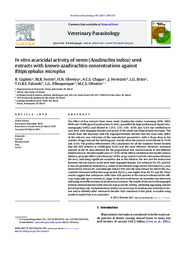In vitro acaricidal activity of neem (Azadirachta indica) seed extracts with known azadirachtin concentrations against Rhipicephalus microplus.
In vitro acaricidal activity of neem (Azadirachta indica) seed extracts with known azadirachtin concentrations against Rhipicephalus microplus.
Autoria: GIGLIOTI, R.; FORIM, M. R.; OLIVEIRA, H. N.; CHAGAS, A. C. de S.; FERREZINI, J.; BRITO, L. G.; FALCOSKI, T. O. R. S.; ALBUQUERQUE, L. G.; OLIVEIRA, M. C. de S.
Resumo: The effec of our extracts from neem seeds (Azadirachta indica) containing 2000,5000,9000 and 10,000 ppm of azadirachtin A (AZA), quantified by high-performance liquid chromatography (HPLC) and diluted to 1.25%; 2.5%; 5.0%; 10.0% and 12.8% was verified by in vitro tests with engorged females and larvae of the cattle tick Rhipicephalus microplus. The results from the bioassays with the engorged females showed that the main toxic effect of the extracts was reduction of the reproductive parameters,with as harpdropin the number of eggs laidand the hatchingrate, mainly when the extracts were diluted to 10.0% and 12.8%.The product effectiveness (PE) calculations for all the solutions tested showed that theAZA solution at 10,000ppm (N10) was the most effective.However, statistical analysis of the PE data obtained for the proportional AZA concentrations in the different diluted extracts showed significance (P < 0.05) of the effects included in the model (extract dilution, principle effect (classificatory) of the assay (extract) and the interaction between the two), indicating significant variations due to the dilution, the testand the interaction between the two factors in the tests with engorged females. For solutions N2, N5,and N9, it was not possible to estimate LC90 values in the dilution range tested.The lowest LC50 was observed for extract N5, and although extract N10 was the only extract for which the LC90 could be estimated with in the range tested, the LC50 was higher than for N5 and N9.These results suggest that substances other than AZA presentin the extracts influenced the efficacy, especially up to acertain LC range. In the tests with larvae, nomortality was observed, indicating zero effectiveness of all the extracts tested.The results of the tests with engorged females showed that the neem extracts had acaricide activity, inhibiting egg laying and the larval hatching rate. Complementary studies are necessary to develop new methods to isolate and/ oridentify other substances be sides AZA contained in this plant, to enable using products made from it as acaricides.
Ano de publicação: 2011
Tipo de publicação: Artigo de periódico
Unidade: Embrapa Pecuária Sudeste
Palavras-chave: Bioinsecticide, Control, Tick
Observações
1 - Por padrão são exibidas publicações dos últimos 20 anos. Para encontrar publicações mais antigas, configure o filtro ano de publicação, colocando o ano a partir do qual você deseja encontrar publicações. O filtro está na coluna da esquerda na busca acima.
2 - Para ler algumas publicações da Embrapa (apenas as que estão em formato ePub), é necessário ter, no celular ou computador, um desses softwares gratuitos. Sistemas Android: Google Play Livros; IOS: iBooks; Windows e Linux: software Calibre.
Acesse outras publicações
Acesse a Base de Dados da Pesquisa Agropecuária (BDPA) para consultar o acervo completo das bibliotecas da Embrapa.

